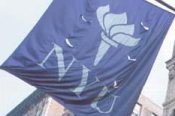
|
||||||||||||||||||

|

|

|
|
Computer Graphics PhD Exam Monday, August 25
2003, 3:00 p.m. at 719 Broaday 12th floor, Large Conference Room. SyllabusYou should be able to write down or derive the basic formulas (e.g. rotation matrix for an arbitrary axis, Phong lighting formula or B-spline subidivsion formula). At the same time, it is not necessary to memorize relatively complex expressions (e.g. Cook-Torrance lighting model, or explicit expressions for radiosity form factors). The books are available at the CAT/MRL library. Please do not take them away for extended periods of time; if necessary, make copies of the relevant sections and chapters. Topics[FFHV] J.D. Foley, A. Van Dam, S.K. Feiner, J.F. Hughes. Computer Graphics: Principl es and Practice, 2nd Edition. [Watt] A. Watt. 3D Computer Graphics, 3rd Edition. [CW] M.F. Cohen, J.R. Wallace. Radiosity and Realistic Image Synthesis. [Glassner] An Introduction to Ray Tracing. edited by A. Glassner. [Subdivision] D. Zorin, P. Schr\366der, A. DeRose, L. Kobbelt, A. Levin, W. Sweldens. SIGGRAPH 2000 Course Notes. Subdivision for Modeling and Animation. http://www.mrl.nyu.edu/publications/subdiv-c ourse2000/ [lecture] Computer Graphics class lecture notes http://www.mrl.nyu.edu/~dzorin/intro -graphics-f01/
Topics1. Scan conversion: Bresenham algorithm for lines. Scan converting convex polygons. (FFHV 3.1, lecture 2-3, Watt 6.4). 2. Image processing: Aliasing and antialiasing. Filtering. Antialiased image scaling . Image blurring and enhancement. (FFHV 14.10, lecture 4-5) 3. Graphics pipeline: general description. Main stages of OpenGL pipeline (FFHV 18.3, OpenGL Programmer's manual, Watt 5.1-5.2). 4. 2D and 3D transformations: linear, affine, perspective. Homogeneous coordinates and matrix representation of 2D and 3D transformations. (FFHV 5.1-5.7, lecture 3,5). 5. Viewing transformations in 3D: conversion of "look-at" specification to matrix form. (lecture 5, Watt 5.1.3). 6. Uniform B-splines: definition through convolution, basic properties. Subdivision rules for uniform quadratic and cubic B-splines. (Subdivision, Ch 2, Watt 3.2) 7. Bicubic spline surfaces. Subdivision surfaces: Catmull-Clark, Loop; definition and basic properties. (Subdivision, Ch 3-4.,Watt 3.4 ) 8. Visible surface algorithms: depth-sort (painter's), z-buffer, ray casting. (FFHV 15.2-15.5, 15.10, Watt 6.6). 9. Radiance, irradiance, radiosity, intensity; physical and perceptual units of light. Phong lighting model. Cook-Torrance model. (FFHV , Glassner Ch 4, Sec 4, CW Ch 2, ). 10. Classical ray tracing. Distributed ray tracing, stochastic sampling. Rendering equation and path tracing. Tracing from light sources. Combined methods. Acceleration techniques. (FFHV 16.12, Glassner Ch 4-5, W 10). 11. Radiosity: basic method, form factors. Hierarchical radiosity. (FFHV 16.13, CW Ch 3-4,7, W 11). 12. Procedural textures. Noise function, fractal models. (Texturing and Modeling, Ch 2, Ch 10-11, W 8.7). 13. Animation: forward and inverse kinematics. (W 17.2-17.3) Sample ExamMarch 2002 (pdf)
top | contact webmaster@cs.nyu.edu
|